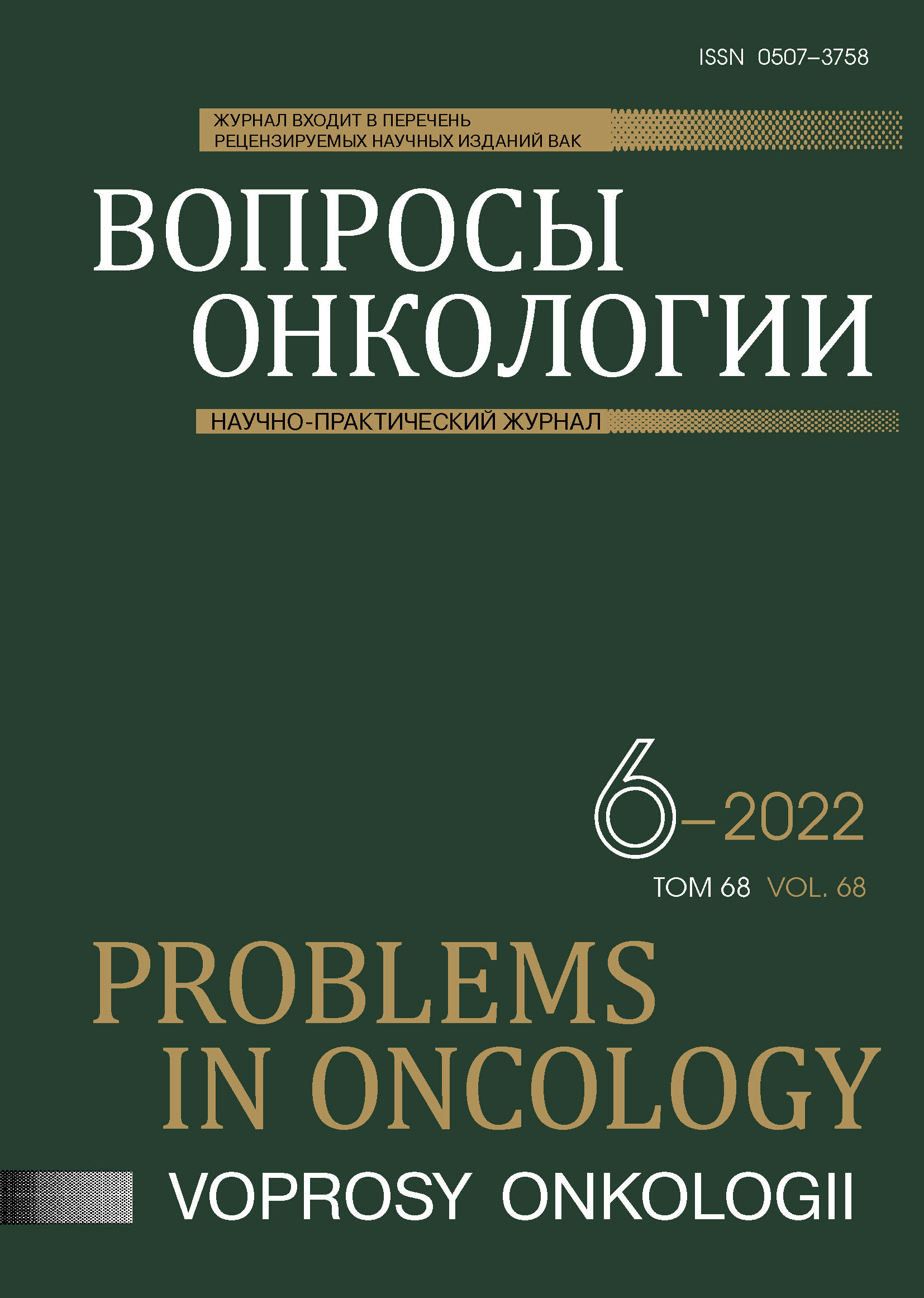Abstract
The current paper is dedicated to the research of the differential expression of blood leukocyte fraction (LF) genes in patients with colorectal cancer (CRC) and polyposis of the lower part of the gastrointestinal tract (GIT).
Aim. Determination of gene expression profiles in peripheral blood LF cells in patients with CRC and polyps of the lower GIT, and creation of logistic regression models, which would make it possible to differentiate patients with CRC, polyposis.
Material and methods. Patients diagnosed with CRC (n=33), polyposis (n=22), as well as control group (n=30) were included in the study.
Gene expression was determined by means of the NGS method. Libraries were prepared with the use of the RNAHyperPrep&HyperCap kit.
NGS was performed on the MiSeq sequencer.
Results. Groups of differentially expressed genes were identified, and logistic regression models were built to differentiate patients diagnosed with CRC (accuracy 93.7%) and polyposis (accuracy 84.6%), in comparison with the control group, as well as patients diagnosed with CRC from patients with polyposis with the accuracy up to 78.3%.
Conclusion. It is necessary to study the expression of genes with the highest diagnostic potential in patients from an independent sampling, using digital RT-PCR, to validate and advance the models we have created.
References
Liew CC, Ma J, Tang HC et al. Peripheral blood transcriptome dynamically reflects system wide biology: a potential diagnostic tool // J Lab Clin Med. 2006;147(3):126–132. doi:10.1016/j.lab.2005.10.005
Marshall KW, Mohr S, El Khettabi F et al. A blood‐based biomarker panel for stratifying current risk for colorectal cancer // Int J Cancer. 2010;126(5):1177–1186. doi:10.1002/ijc.24910
Chang Y-T, Huang C-S, Yao C-T et al. Gene expression profile of peripheral blood in colorectal cancer // World J Gastroenterol. 2014;20(39):14463–14471. doi:10.3748/wjg.v20.i39.14463
Han M, Liew CT, Zhanget HW et al. Novel blood-based, five-gene biomarker set for the detection of colorectal cancer // Clin Cancer Res. 2008;14(2):455–460. doi:10.1158/1078-0432.CCR-07-1801
Xu Y, Xu Q, Yang L et al. Gene expression analysis of peripheral blood cells reveals toll-like receptor pathway deregulation in colorectal cancer // PloS One. 2013;8(5):e62870. doi:10.1371/journal.pone.0062870
Tsouma A, Aggeli C, Lembessis P et al. Multiplex RT-PCR-based detections of CEA, CK20 and EGFR in colorectal cancer patients // World J Gastroenterol. 2010;16(47):5965–5974. doi:10.3748/wjg.v16.i47.5965
Findeisen P, Röckel M, Nees M et al. Systematic identification and validation of candidate genes for detection of circulating tumor cells in peripheral blood specimens of colorectal cancer patients // Int J Oncol. 2008;33(5):1001–1010. doi:10.3892/ijo_00000088
Eisenach PA, Soeth E, Röder C et al. Dipeptidase 1 (DPEP1) is a marker for the transition from low-grade to high-grade intraepithelial neoplasia and an adverse prognostic factor in colorectal cancer // Br. J. Cancer. 2013;109(3):694–703. doi:10.1038/bjc.2013.363
Liu Q, Deng J, Yang C et al. DPEP1 promotes the proliferation of colon cancer cells via the DPEP1/MYC feedback loop regulation // Biochem Biophys Res Commun. 2020;532(4):520–527. doi:10.1016/j.bbrc.2020.08.063
Toiyama Y, Inoue Y, Yasuda H et al. DPEP1, expressed in the early stages of colon carcinogenesis, affects cancer cell invasiveness // J Gastroenterol. 2011;46(2):153–163. doi:10.1007/s00535-010-0318-1
Gao Y, Zens P, Su M et al. Chemotherapy-induced CDA expression renders resistant non-small cell lung cancer cells sensitive to 5′-deoxy-5-fluorocytidine (5′-DFCR) // J Exp Clin Cancer Res. 2021;40:138. doi:10.1186/s13046-021-01938-2
Wentzensen N, Wilz B, Findeisen P et al. Identification of differentially expressed genes in colorectal adenoma compared to normal tissue by suppression subtractive hybridization // Int J Oncol. 2004;24(4):987–994. doi:10.3892/ijo.24.4.987
Williet N, Petcu CA, Rinaldi L et al. The level of epidermal growth factor receptors expression is correlated with the advancement of colorectal adenoma: validation of a surface biomarker // Oncotarget. 2017;8(10):16507–16517. doi:10.18632/oncotarget.14961
Zheng H, Tsuneyama K, Cheng C et al. Maspin expression was involved in colorectal adenoma-adenocarcinoma sequence and liver metastasis of tumors // Anticancer Res. 2007;27(1A):259–265.
Chan CHF, Stanners CP. Recent advances in the tumour biology of the GPI-anchored carcinoembryonic antigen family members CEACAM5 and CEACAM6 // Curr Oncol. 2020;14(2):70–73. doi:10.3747/co.2007.109
Du K, Ren J, Fu Z et al. ANXA3 is upregulated by hypoxia-inducible factor 1-alpha and promotes colon cancer growth // Transl Cancer Res. 2020;9(12):7440–7449. doi:10.21037/tcr-20-994
Zhang C, Zhao Z, Liu H et al. Weighted gene co-expression network analysis identified a novel thirteen-gene signature associated with progression, prognosis, and immune microenvironment of colon adenocarcinoma patients // Front Genet. 2021;12:657658. doi:10.3389/fgene.2021.657658
Rehli M, Krause SW, Schwarzfischer L et al. Molecular cloning of a novel macrophage maturation-associated transcript encoding a protein with several potential transmembrane domains // Biochem Biophys Res Commun. 1995;217(2):661–667. doi:10.1006/bbrc.1995.2825
Urban-Wojciuk Z, Khan MM, Oyler BL et al. The role of TLRs in anti-cancer immunity and tumor rejection // Front Immunol. 2019;10:2388. doi:10.3389/fimmu.2019.02388
Söylemez Z, Arıkan ES, Solak M et al. Investigation of the expression levels of CPEB4, APC, TRIP13, EIF2S3, EIF4A1, IFNg, PIK3CA and CTNNB1 genes in different stage colorectal tumors // Turk J Med Sci. 2021;51(2):661–674 doi:10.3906/sag-2010-18
Zhao F, Yang G, Feng M et al. Expression, function and clinical application of stanniocalcin-1 in cancer // J Cell Mol Med. 2020;24(14):7686–7696 doi:10.1111/jcmm.15348
Hou H, Sun D, Zhang X. The role of MDM2 amplification and overexpression in therapeutic resistance of malignant tumors // Cancer Cell Int. 2019;19:216. doi: 10.1186/s12935-019-0937-4

This work is licensed under a Creative Commons Attribution-NonCommercial-NoDerivatives 4.0 International License.
© АННМО «Вопросы онкологии», Copyright (c) 2022
